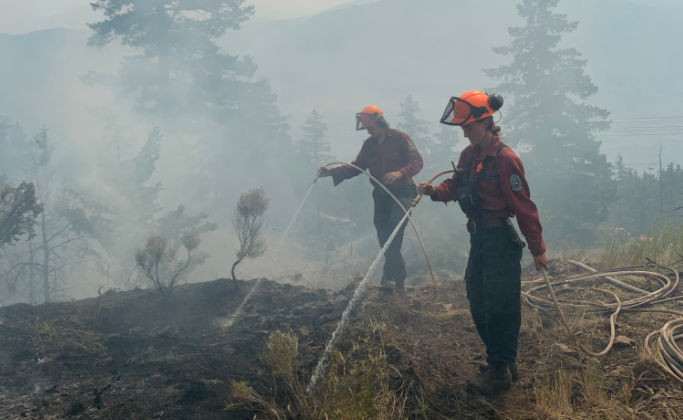Wildfires continue to rage around the Fort St. John area.
In the Peace Region crews are continuing to battle four out of control fires of note.
The Stoddart Creek Wildfire northwest of Fort St. Jon has grown to an estimated 23,500 hectares.
Nearby, the Red Creek Fire remains at a mapped 2,947 hectares.
The BC Wildfire Service (BCWS) says fire activity and behaviour is anticipated to continue to display aggressive rates of spread, with intermittent crowning into foliage and a coordinated flame front in both of those blazes.
The BCWS noted that crews withdrew from those fires due to aggressive fire behaviour.
“It was anticipated by our advanced planning unit that the wind was going to shift yesterday and push from the North and move that fire into fuel that was very receptive to burn,” said BCWS Wildfire Operations Director Cliff Chapman.
“If a fire has wind on it and can get up and run, it becomes extremely dangerous for our ground crews we continue to fly aviation resources but as the conditions are what they are in the northeast, it becomes ineffective.”
The Donnie Creek Wildfire has grown to an estimated 43,270 hectares in size, and the Cameron River Wildfire is estimated at 352 hectares.
The BCWS is also reporting a new out of control wildfire near Milligan Lake, south of Fort Fraser, that has grown to 41 hectares in size.
According to the BCWS, crews worked overnight and made significant progress in establishing fire guards with heavy equipment and helicopter buc
“What we’ve seen in the northeast in particular, Prince George and north, is we’ve seen very challenging fire conditions, very challenging fuel conditions, and weather that is not really cooperative for our response efforts,” Chapman said.
“We’re entering into a state for the next number of days, in particular in the north but it’ll start to come into the south, as well what we call crossover conditions.”
Chapman said that means the temperature is higher than the relative humidity.
“When we see crossover conditions, that’s when we’re really challenged with our suppression efforts, whether it be on the ground or aviation resources,” he said.
“We will still be out there, we will still be out there, we will still be attempting to control all the fires existing and new that begin. I just think it’s important for everyone to know that the fuel conditions being what they are and the weather being what it is, it is going to be challenging suppression efforts across the province.”
Chapman added the fire season for July, August and September depends on June rain.
“That remains the same, we are now in a position though with our drying across the province and our fuels being so receptive to ignition and fire spread, that the June rains are the biggest variable for us as we head into the core fire season,” Chapman said.
“Obviously as we sit here right now, we are in the core fire season in parts of the province as we’re actively suppressing upwards of 50,000 hectares of fire in the Northeast alone.”
Chapman said a province-wide category 2 and 3 fire prohibition will go into effect on Thursday.
“In addition to that, we’re going to see a campfire prohibition go into place for the Prince George Fire Centre, that will be effective on Thursday as well.”
Chapman also noted there isn’t anything in the long-term forecast that has him nervous about what’s to come.
As of 1:30 p.m., there are 60 active wildfires in the province, including 22 in the Prince George Fire Centre.
Something going on in the Bulkley Valley Lakes District you think people should know about?
Send us a news tip by emailing [email protected].





